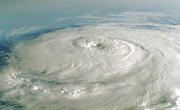
Air masses are important features of the atmosphere that have a strong influence on weather patterns. An air mass is a volume of air with a large horizontal spread – typically in the range of 1,600 kilometers (1,000 miles) or more – that originates in a particular geographic region with uniform temperatures. Air masses that originate near the equator are typically warm and moisture-laden, and they feed types of storms on Earth such as tropical rain forests and fuel hurricanes. Air masses move vertically, with cold masses sinking and pushing warm air masses up. Convection currents are produced by the temperature differences in air masses, which makes wind.
Classification of Air Masses
Meteorologists classify air masses according to the latitude at which they develop and whether they develop over land or over the ocean. Arctic and Antarctic air masses develop at the highest latitudes, polar air masses at slightly lower ones, followed by tropical ones and finally equatorial air masses.
Those that develop over water are maritime masses, while those that develop over land are continental masses. Continental masses are typically dry, while maritime ones are moist. Only six air masses exist because Arctic air is seldom moist, and equatorial air is seldom dry.
Equatorial Masses Produce Frequent Thunderstorms
Equatorial air masses develop at latitudes from 25 degrees north to ten degrees south. Temperatures are high, and because there isn't much land at those latitudes, equatorial air masses are all maritime. They are laden with moisture because water readily evaporates into the hot air at the Equator.
Warm air has a tendency to rise, and the trade winds that prevail near the equator push it into the cooler upper atmosphere, where the moisture condenses into ice crystals and turns into rain as it falls to the ground. Consequently, thunderstorms are frequent in regions dominated by equatorial air masses.
Wind and Rain
The air at the Equator is, on average, the hottest on Earth, and its tendency to rise into the upper atmosphere creates areas of low pressure. As a result, cooler air rushes in from higher latitudes to fill the semivacuum, creating strong and consistent winds. These winds tend to die out near lower degrees latitude to become weak and variable.
The winds push the warm air high into the atmosphere, where temperatures are cool and towering clouds are typical. The frequent rainstorms feed the equatorial rainforests of the Amazon and Congo basins as well as those of the East Indies.
Types of Storms on Earth
Hot temperatures at the Equator can drive saturated water into the upper atmosphere at an accelerated rate, creating strong winds as cooler air rushes in to replace it. If this occurs far enough from the equator, the Coriolis force caused by the Earth's rotation deflects the winds, and they can begin to spiral around a central point of low pressure, called the eye.
When the wind speeds reach 62 kilometers per hour (39 miles per hour), a tropical storm is born, and if the wind speed increases to 119 kilometers per hour (74 miles per hour), it becomes a hurricane or cyclone. Tropical cyclones, extratropical cyclones and tornadoes are all types of cyclones. They are distinguished from one another by top wind speeds and where they form.
Tropical storms are also called different things in different parts of the world; for instance, they are called hurricanes in the Northern Atlantic Ocean and typhoons in the northeast Pacific Ocean. Additionally, each hurricane is assigned a male or female name by the National Oceanic and Atmospheric Association, or NOAA. These names help meteorologists track tropical storms and communicate with the public about them.
References
About the Author
Chris Deziel holds a Bachelor's degree in physics and a Master's degree in Humanities, He has taught science, math and English at the university level, both in his native Canada and in Japan. He began writing online in 2010, offering information in scientific, cultural and practical topics. His writing covers science, math and home improvement and design, as well as religion and the oriental healing arts.
